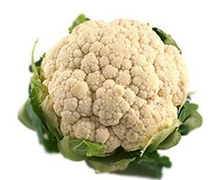
- Address : P.O. Box 11, Gannoruwa rd, Peradeniya, Sri Lanka
- E- Mail : director.hordi@doa.gov.lk
- Telephone :(+94) 081-2388011-12-13
- Fax :(+94) 081-2388234

Cauliflower
Brassica oleracea var. botrytis
An introduced, highly nutritious vegetable. Different varieties are available which can be grown in different areas of the country.
Recommended varieties
Climate requirements/ Areas suitable for cultivation
Suitable for all agro ecological zones. Varieties are available which can be grown in up country, low country and intermediate zone.
Soil
Well drained, loamy soils are preferred. Optimum pH is 6.0 -6.8.
Cultivation Time
Mid country wet zone – January, February and November, December
Up country wet zone – January to March and October to December
Up country intermediate zone – January, February and November, December
are suitable for seedling establishment.
Seed requirement
300 g / ha
Spacing
Between rows 40 -50 cm and within rows 40 cm
Land preparation and planting
Land should be plough up to 30 – 40 cm depth and level the land. 3 – 4 weeks old healthy seedlings can be grown in raised beds or ridges.
Nursery Management
Prepare raised beds with fine soil with the width of 1 m and height of 20 cm. Seed sowing can be done as broadcasting or row seeding.
Water supply/ Irrigation
Irrigate every day until seedlings established in the field. Then, irrigate every 2 days up to 2 weeks. Later, supply water depending on the rain fall.
Crop maintenance
Shading should be done to prevent wilting of seedlings just after transplanting. Flower heads should be covered with adjacent leaves to prevent direct sunlight.
Weed Control
Hand weeding should be done at 2 and 4 weeks after planting.
Fertilizer
Nuwara Eliya District
Time of application | Urea (kg/ ha) | Triple Super Phosphate (kg/ha) | Muriate of Potash (kg/ha) |
Basal application | – | 270 | 75 |
2 weeks after transplant | 110 | – | – |
5 weeks after transplant | 110 | – | 75 |
8 weeks after transplant | 110 | – | – |
Other districts
Time of application | Urea (kg/ ha) | Triple Super Phosphate (kg/ha) | Muriate of Potash (kg/ha) |
Basal application | 110 | 270 | 75 |
3 weeks after transplant | 110 | – | – |
6 weeks after transplant | 110 | – | 75 |
Note: Better to apply Phosphorous and Potassium fertilizers to the soil as a basal dressing, after soil sample analysis.
Pest Management
Looper caterpillar, diamond black moth and black worm are common pests and management same as in cabbage
Disease Management
Club root, black rot, downy mildew and bacterial soft rot are commonly can be seen at the field. Damping off at the nursery stage can be seen with poor drainage. Symptoms and disease management are similar to cabbage.
Causal Organism: Plasmodiaphora brassicae
Symptoms
- Swelling or malformation on the main lateral roots those are called club rootsand those galls appear like clubs or spindles on the roots
- The crop can be completely destroyed due to damage
Management
- Keeping the soil at a slightly basic pH of 7.1 -7.2 by the addition of agricultural lime and apply 2- 4 t/ha of lime to raise soil pH.
- Use of disease free planting materials
- As well as the integration of crop rotation
Causal Organism : Fusarium , Phythium , Rhizoactonia spp.
Symptoms
- Damping-off kills seedlings before or soon after they emerge. Seedlings that emerge develop a lesion near where the tender stem contacts the soil surface
Management
- Sterilize the soil with fungicide (Thiphinate, methyl / Thiram) or burning
- Drench the nursery beds with fungicide solution
Harvesting and Processing
Heads are ready to harvest around 60 – 75 days after transplant. However, this may be vary with the variety and agro ecological zone.
Yield
6.0 – 9.0 t/ ha
